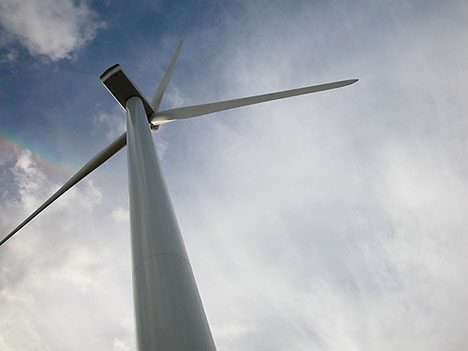We’ve all heard that wind energy is too expensive, and that massive investments in wind will drive up electricity rates for consumers. This argument is based on the belief that wind energy is more expensive on a per kilowatt-hour basis than traditional fossil fuels. While even this premise is up for debate (for example, wind is now the least expensive option for new generation for some utilities in the upper Midwest), the bigger problem is that this argument ignores how electricity markets actually work.
According to a study by Synapse Energy Economics that was released today, electricity markets are structured in such a way that wind power will actually lower wholesale power prices, which can ultimately reduce consumers’ electric bills. The Synapse study, which was released at an event organized by Americans for a Clean Energy Grid, finds that making substantial investments in wind power (and the necessary transmission lines to bring that wind to market) could save the average Midwestern residential consumer as much as $200 per year in 2020.
The key to understanding how this works is something called “price suppression”. In competitive power markets, like the one managed by the Midwest Independent System Operator (MISO), power is sold through an auction. Generators bid in a certain amount of power at a certain price. When the market is functioning properly, the price is always the marginal cost of operating the power plant. For a natural gas plant, the marginal cost is primarily fuel, with some amount of labor and other expenses. For a wind turbine, the marginal cost is effectively zero, since there’s no fuel cost and there are minimal other operating expenses. MISO has a supply curve, ranging from very low marginal cost resources like wind, through nuclear and coal, and ultimately ending at very expensive power from inefficient peaking plants fired with natural gas.
In these power auctions, the “clearing price” is the price bid by the most expensive generator whose bid is accepted. So, if the MISO market needs power from a costly peaking plant, the clearing price is very high. Every generator receives the clearing price, no matter what price they bid into the auction.
The price suppression effect refers to the fact that when lower marginal cost resources come into the market, there’s less need for higher cost resources. This reduces the clearing price, which is the price that utilities have to pay for wholesale power. This is also known as the “merit order effect” and is described in more detail in a recent paper on Germany.
The Synapse economists looked at how much bringing new wind power into the market would reduce clearing prices. This leads to significant savings. Then, they accounted for the fact that new wind requires new transmission by subtracting the expected cost of new transmission investments. Finally, they assumed that not all of these savings would flow through to consumers, and cut the savings in half.
They ran several scenarios based on different amounts of wind, different transmission costs, and different mixes of fossil fuel generation. This results in net savings for consumers ranging from $63 to $200 per year.
Unfortunately, consumers will only see these savings if more wind and transmission lines actually get built. Making this happen requires protecting FERC Order 1000 (which sets out new processes for planning and paying for transmission) and state renewable energy standards (which require utilities to get a certain amount of their power from resources like wind) from attack.
While the Synapse study applies to a generic customer within the MISO region, it’s important to understand that the actual impacts on different customers will vary, and that this effect doesn’t necessarily translate perfectly to other power markets across the country. For one, some utilities within MISO still operate as vertically-integrated businesses, which means that they purchase very little power on the MISO market. These utilities’ customers would likely see less impact on their electric bills. And, this study essentially treats the spot market price as a perfect substitute for the overall wholesale cost of power. In actuality, the wholesale cost of power is determined by a mix of spot market purchases, power purchase agreements, bilateral contracts, and utility-owned generation, and each utility has a different cost structure. Identifying the actual rate impact of a specific wind investment on a specific customer is extremely complicated, and should be addressed through existing processes, including state public utility commission investigations.
MISO is also unique because it’s only an “energy” market. That is, only megawatt-hours are sold in MISO. In other markets, like PJM in the mid-Atlantic of ISO-New England, utilities also buy capacity, measured in megawatts. In those markets, generators whose income is reduced because of price suppression could theoretically offset some of that effect by bidding higher prices in the capacity market. The actual impact of this is disputed, because many observers think that capacity markets function fairly poorly and market rules would likely prevent generators from increasing their bids. For a more thorough description of this issue, see the Brattle Group’s analysis of the Atlantic Wind Connection.
Finally, there are some broader issues. First, economic theory suggests that in the long term, generators will leave the market if their income (and thus profit) is reduced. This would reduce the amount of available generation, and could very well offset the price suppression effect. This is described by Frank Felder in his recent paper, “Examining Electricity Price Suppression Due to Renewable Resources and Other Grid Investments”. Second, it’s worth noting that there are practical limits to price suppression. Imagine if 100 percent of the electricity were supplied by wind. The logical conclusion would be that the clearing price would always be zero, and that electricity would be free. Obviously, no one would build generation if this was the case, so markets will likely have to adapt to encourage more wind generation in the future.
At the same time, there are reasons to think that Synapse has undercounted some consumer benefits of building wind and transmission. Most important, this study does not include a price on carbon, or any other pollution or externalities. This alone would make it abundantly clear that wind power is a much cheaper alternative to fossil fuels. And, not only does new transmission bring wind power to consumers, it will also help alleviate congestion on MISO’s grid and allow cheaper power to flow freely across the whole system. This will reduce wholesale power costs, and is not included in the Synapse study.
Obviously, there always the potential for more research on issues like this. But, this much is clear: price suppression can play an important role in reducing consumers’ electricity bills, and the market impacts of bringing wind into competitive markets outweigh the cost of building the needed new generation.
Wind power truly is affordable, reliable, and clean.
Richard Caperton is Director of Clean Energy Investments at the Center for American Progress.








